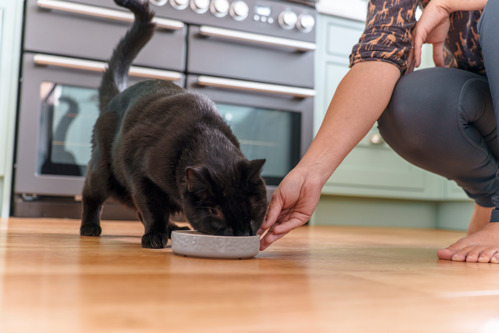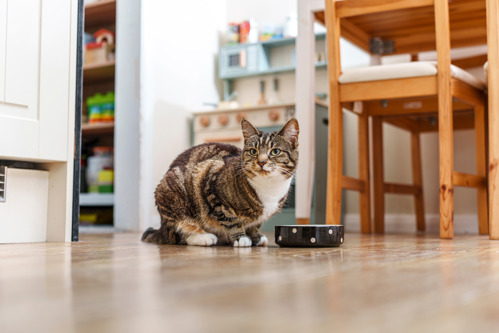Vet experts explain top reasons why cats eat the jelly or gravy but not the meat
As a cat owner, you may have observed some quirky eating habits from your furry friend. One of the most common complaints is: "Why does my cat only lick the jelly off their wet food?" It’s frustrating to serve your cat a delicious meal, only to find the meaty chunks left behind while the jelly or gravy is completely licked clean.
While this behaviour might seem confusing, it is quite common for cats. There are a few possible reasons behind it. In this post, Cats Protection vet experts explain why cats only eat the jelly and give practical tips to help encourage your cat to eat a whole meal.

Why does my cat only eat the jelly or gravy from their wet food?
1. Dental problems or discomfort
If this a new behaviour for your cat and they used to eat the meaty chunks in their food, then this could be a sign that something is wrong with their health. They may have lost their appetite due to a medical issue, or they may have dental problems making it painful to eat. Dental issues like tooth decay, gum disease or mouth pain can make chewing solid food uncomfortable. This could cause your cat to avoid the chunks and lick only the softer jelly or gravy. This is much easier for them to eat.
What you can do: If your cat does not want to eat something that they used to like, speak to your vet to find out if there could be a medical cause. Your vet can recommend softer food options if necessary. Find more advice about cat dental care.
2. Cats prefer soft textures
Cats often have strong preferences when it comes to texture. The jelly in wet cat food has a soft, smooth texture that cats enjoy lapping up. The solid chunks may not be as enjoyable for cats that prefer softer, easier-to-eat foods.
What you can do: Try mashing the meaty chunks up with a fork to make them more palatable. Or you could offer a pâté-style cat food instead of chunk-based meals. Pâté cat foods are smoother and have a more consistent texture that cats might find easier to eat.
3. Natural instincts from the wild
In the wild, cats eat the most nutrient-rich and hydrating parts of their prey first. The organs of their prey, which are high in moisture and nutrients, are typically their first choice. The jelly or gravy in wet cat food mimics this moist texture, appealing to their natural instincts. Your cat might be prioritising the jelly as the closest substitute for these nutrient-dense parts.
What you can do: Ensure your cat is getting enough nutrition by choosing high-quality, complete, balanced wet foods. You can also consult your vet for recommendations on nutrient-rich cat food options.
4. Hydration needs
Cats are not naturally big drinkers and often rely on their food for hydration. The jelly or gravy in wet cat food is full of moisture, which can help keep your cat hydrated. One theory is that if your cat isn’t drinking enough water, they may instinctively go for the jelly or gravy in their food to increase their fluid intake.
What you can do: Encourage your cat to drink more water by providing several different bowls of fresh water around the house. Placing their water bowl away from their food bowl may also encourage them to drink more. Find more advice on cats and drinking.
5. Your cat is a picky eater
Let’s face it, cats can be fussy. Your cat might simply be a picky eater, preferring the taste and texture of the jelly over the rest of the food. Once they've tasted the best part, in their opinion, they leave the less appealing chunks behind.
What you can do: If your cat is picky, try different brands or flavours of wet cat food until you find one they like enough to eat completely.
Why does my cat never finish their food?

1. Dental problems or discomfort
If this a new behaviour for your cat and they used to finish their meals, then this could be a sign that something is wrong with their health. They may have a medical problem affecting their appetite. Or they may have mouth pain making it uncomfortable for them to eat.
What you can do: If your cat has gone off their food, speak to your vet to find out if there could be a medical cause. For example, dental problems.
2. The portions are too big
Your cat may not be finishing their meals because you are giving them too much. Cats have small stomachs. Most cats prefer to eat several smaller meals throughout the day, rather than one or two big meals. This mimics how they would eat in the wild, catching several small prey animals each day. If you're offering too much food at once, they may eat a little and leave the rest.
What you can do: Check the packaging of the cat food to see how much you should be feeding your cat each day. Split this amount up into smaller, more frequent meals offered to your cat throughout the day.
3. They’re too full up from treats
Cat treats contain a lot of calories. If you’re giving your cat a lot of treats alongside their regular cat food, they might be too full to eat their main meals.
What you can do: Limit the amount of cat treats you give to your cat. Try treating them fuss or play for a healthier alternative. If you do give your cat treats, reduce the amount of regular cat food you give them. This will make sure they are getting the correct amount of calories each day.
4. Their bowl is in the wrong place
Cats usually like to eat in a quiet, private area, away from noise, people and other animals. They also prefer to eat away from their water bowl and litter tray to avoid cross-contamination. If your cat’s food bowl is in the wrong place, they may feel uncomfortable eating their entire meal.
What you can do: Place your cat’s food bowl in a quiet, low-traffic area where they feel safe. Ensure the bowl is clean, as some cats are sensitive to the smell of leftover food or residue. Consider using shallow bowls or plates, as some cats prefer these over deep bowls.
5. Stress or anxiety
Stress or anxiety can affect your cat’s appetite. Big changes can cause stress, such as moving to a new home, introducing a new pet, or even changes in their daily routine. Stress can lead to a decrease in appetite or cause your cat to eat smaller amounts.
What you can do: Try to minimise stress by keeping a consistent feeding schedule. Make any changes to your cat’s environment gradually. Make sure your cat has somewhere quiet to hide away when they feel stressed, as this helps them feel safe. Find out more about cat stress.
6. The food isn’t fresh enough
Cats are notoriously picky eaters. One of the biggest reasons they don’t finish their food is that they prefer it fresh. Once food has been sitting out for a while, it may lose its appeal due to changes in texture, temperature or smell. Wet food in particular dries out and becomes less appetising after being exposed to air.
What you can do: Serve smaller portions that your cat can finish in one sitting. Also offer food more frequently throughout the day. If you’re feeding wet food, you can cover and refrigerate leftovers. Then reheat them slightly to bring back their aroma and flavour.
7. Your cat is a picky eater
Cats can be very fussy, especially when it comes to the flavour or texture of their food. If your cat is used to a certain brand or type of food, they may refuse to eat anything else. Or only nibble at food that doesn’t meet their high standards.
What you can do: Stick to flavours and textures your cat has enjoyed in the past. If you need to change their food, do it gradually by mixing the new food with the old. Slowly increase the ratio of the new food over several days to avoid digestive issues.
How to encourage your cat to finish their wet food
- Serve it at room temperature. Wet cat food served straight from the fridge is unappealing to some cats. They may leave it and wait until it has warmed up to room temperature. But by this time, it may have dried out and become unappealing for a different reason. Keep their food in a cupboard, instead of the fridge.
- Warm it up. If they won’t eat the food at room temperature, try gently warming it up in the microwave. This can help to enhance the smell of the food, making it more appealing for your cat. Make sure it’s not too hot for them to eat.
- Mash it up. If your cat isn’t keen on the chunks of meat in their wet food, try mashing them up with a fork for a different consistency. Or you could offer them a pâté-style cat food as the smoother, mousse-like texture may be more appealing.
- Keep it fresh. The sight and smell of stale cat food left in their bowl can affect your cat’s appetite. Serve several small meals throughout the day that your cat can finish in one sitting. Clear away any uneaten food after half an hour and clean the bowl with soap and water.
- Keep feeding areas quiet. Ensure that your cat’s food bowl is in a quiet area where they won’t be disturbed. Keep it away from their water bowl and litter tray to avoid cross-contamination.



